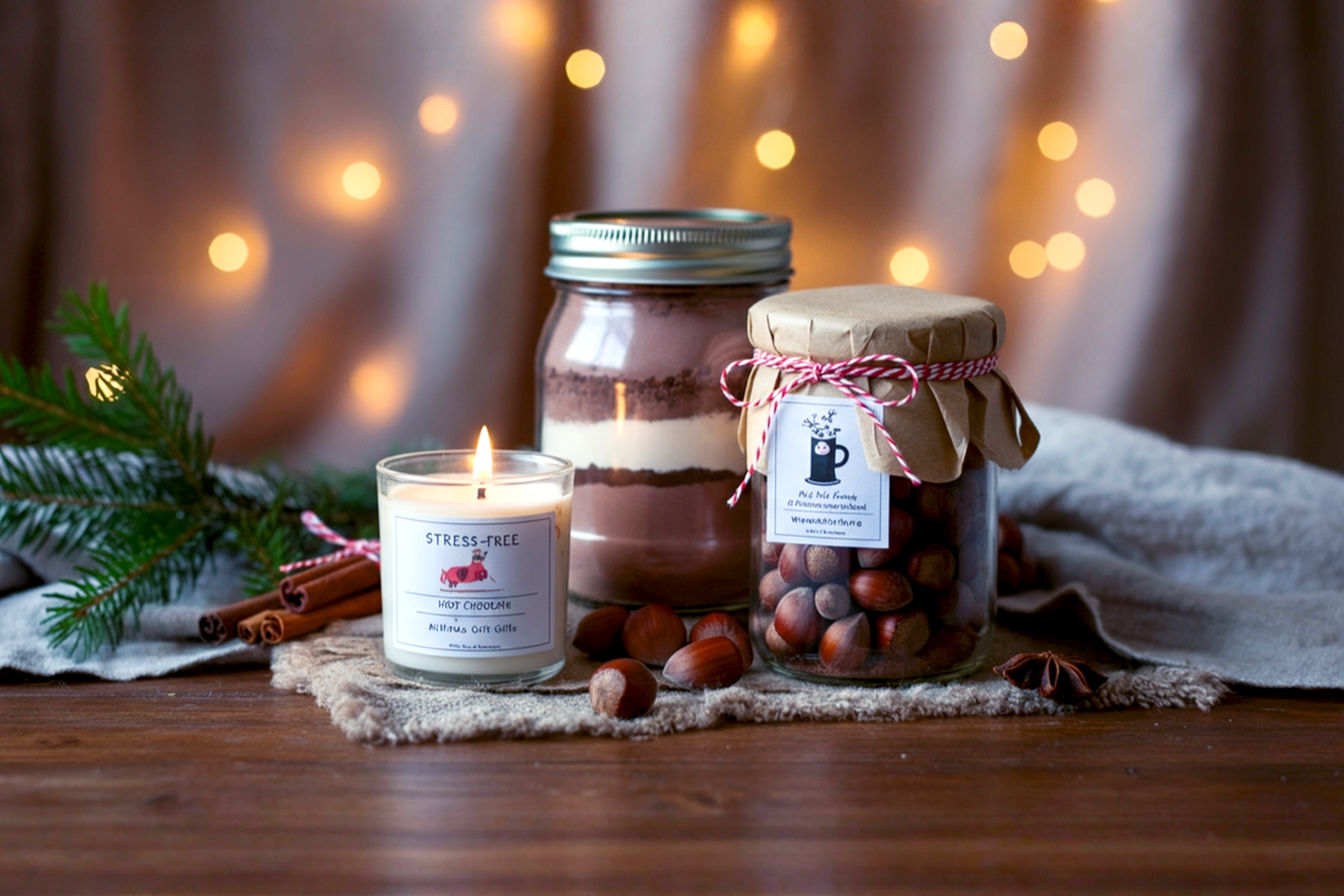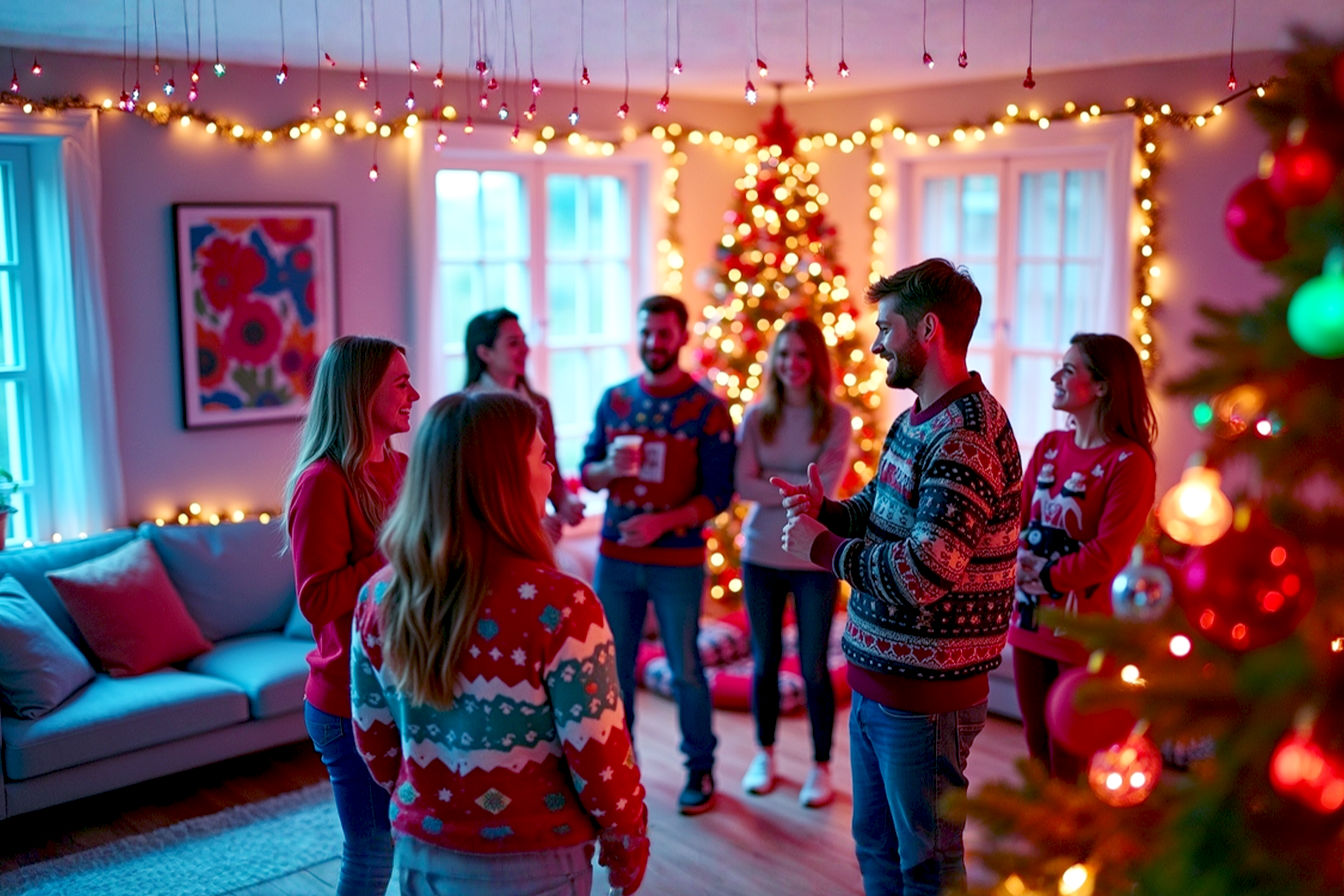This post may contain affiliate links. If you make a purchase through these links, we may earn a commission at no additional cost to you.
The holiday season brings a unique kind of magic, a time when homes sparkle with festive lights, the scent of pine fills the air, and anticipation builds for cherished moments. At the heart of this season lies the Christmas tree, a beacon of holiday cheer, often surrounded by a colorful array of carefully chosen presents. But the true spirit of Christmas isn’t just about the gifts we receive; it’s profoundly rooted in the joy of giving. This isn’t just a sentimental idea; it’s a powerful feeling that brings deep satisfaction and strengthens our connections with others.
This comprehensive guide will explore the profound meaning behind giving during Christmas, offering creative and thoughtful ideas for presents that truly resonate. We’ll also delve into how to beautifully integrate these gifts with your Christmas tree, transforming your living space into a heartwarming display of generosity and love. From understanding the psychological benefits of giving to mastering the art of presentation, we’ll help you unlock the full potential of this wonderful holiday tradition. Get ready to discover how to make your Christmas tree not just a centerpiece of decoration, but a vibrant symbol of the true spirit of giving.
The Heart of the Holiday: Understanding the Joy of Giving
The act of giving, especially during the Christmas season, holds a special power. It’s more than just exchanging items; it’s about connection, empathy, and spreading happiness. There’s a deep satisfaction that comes from seeing someone’s face light up because of your thoughtfulness. This feeling, often described as the “joy of giving,” is a core component of the holiday experience.
The Science Behind Giving Happiness
Have you ever noticed how good it feels to give someone a gift they truly love? That warm, fuzzy feeling isn’t just in your head; it’s a real neurological phenomenon. When we engage in acts of generosity, our brains release a cocktail of feel-good chemicals. Specifically, studies in neuroeconomics and psychology show that giving activates the brain’s reward centers, releasing dopamine, the neurotransmitter associated with pleasure and motivation. It also triggers the release of oxytocin, often called the “love hormone,” which promotes bonding and social connection.
This isn’t just about a fleeting moment of happiness. Research suggests that altruistic behavior can lead to sustained well-being. For instance, a study published in the International Journal of Behavioral Medicine found that people who volunteered regularly reported greater life satisfaction and lower rates of depression. The act of giving can also reduce stress and even improve physical health. When you give, you’re not just making someone else happy; you’re also boosting your own mental and physical health. It’s a powerful feedback loop: the more you give, the happier you become, and the more inclined you are to continue giving. This intrinsic reward system is why the “joy of giving” is such a universal and enduring concept.
Beyond Materialism: The True Spirit of Christmas
In a world often focused on consumption, it’s easy to get caught up in the commercial aspects of Christmas. The advertisements for the latest gadgets, the pressure to buy the “perfect” gift, and the sheer volume of holiday shopping can sometimes overshadow the deeper meaning. However, the true spirit of Christmas transcends material possessions. It’s about love, compassion, and connection.
Historically, Christmas celebrates the spirit of generosity and hope. The tradition of gift-giving itself is rooted in ancient customs and religious narratives that emphasize sharing and benevolence. It’s a time to reflect on our blessings and extend kindness to others, especially those less fortunate. When we shift our focus from “what can I get?” to “what can I give?”, the holiday transforms into something far more meaningful. It becomes an opportunity to show appreciation, offer support, and create lasting memories. This doesn’t mean gifts aren’t important; rather, it means the intention and thought behind the gift are what truly matter. A simple, heartfelt gesture can often be more impactful than an expensive, impersonal present.
Cultivating a Culture of Generosity
The joy of giving isn’t just an individual experience; it’s something that can be fostered and shared within families and communities. When children see their parents engaging in thoughtful giving, they learn valuable lessons about empathy and kindness. It teaches them that happiness can come from contributing to others’ well-being, not just from receiving.
Families can cultivate a culture of generosity through various practices. This might involve choosing a charity together to support, volunteering time at a local shelter, or creating handmade gifts for neighbors. These activities build a sense of collective purpose and reinforce the idea that Christmas is a time for sharing our resources, whether they are material goods, time, or talents. By making giving a central part of your family’s holiday traditions, you’re not just celebrating a season; you’re building character and instilling values that will last a lifetime. It’s about creating a ripple effect of kindness that extends far beyond your immediate circle, enriching the entire community.
The Christmas Tree as a Symbol of Giving
The Christmas tree stands as an iconic symbol of the holiday season, its twinkling lights and festive ornaments bringing warmth and cheer to homes around the world. But beyond its decorative appeal, the tree also serves as a powerful focal point for the tradition of giving, especially when surrounded by a bounty of presents.
A Brief History of the Christmas Tree Tradition
The tradition of bringing evergreen trees indoors for winter celebrations dates back centuries, long before Christianity. Ancient cultures, like the pagans, used evergreens to symbolize life and rebirth during the darkest days of winter, believing they would ward off evil spirits. The modern Christmas tree tradition, however, largely originated in 16th-century Germany. German Christians began decorating trees with candles and apples, bringing them into their homes as a symbol of hope and new life.
This custom gained popularity in England in the 19th century, particularly after Queen Victoria and her German husband, Prince Albert, were depicted with a decorated Christmas tree in 1846. This image quickly spread, and the Christmas tree became a widespread tradition across the English-speaking world and beyond. Over time, the decorations evolved from simple candles and fruit to elaborate ornaments, tinsel, and strings of electric lights. The area beneath the tree naturally became the designated spot for presents, transforming it into a central hub for the holiday’s gift-giving ritual.
The Tree as a Central Hub for Holiday Generosity
For many families, the Christmas tree isn’t just a pretty decoration; it’s the heart of their holiday celebrations. It’s where children gather on Christmas morning, eyes wide with excitement, and where families exchange gifts, sharing laughter and creating cherished memories. The tree acts as a natural gathering point, drawing everyone together in anticipation and joy.
The presence of gifts beneath the tree amplifies this role. Each wrapped package represents a thought, a wish, and an act of love. The sheer volume and variety of presents can symbolize the abundance of generosity during the season. It’s a visual representation of the giving spirit, making the abstract concept of generosity tangible and exciting, particularly for younger family members. This central hub facilitates the exchange, making the act of giving and receiving a shared, communal experience.
Integrating Presents into Your Tree’s Aesthetic
While the primary purpose of gifts is to be opened, their presentation under the tree can significantly enhance your overall holiday decor. Think of the area beneath your tree as an extension of its beauty, a carefully curated display rather than just a pile of boxes.
To integrate presents seamlessly, consider your tree’s existing theme and color scheme. If your tree boasts classic reds and greens, opt for wrapping paper in complementary shades, perhaps with gold or silver accents. For a rustic, natural tree, choose kraft paper, twine, and natural embellishments like pinecones or dried orange slices. Cohesive wrapping creates a unified and elegant look, making the presents appear as part of the decor, not separate from it. You can also use ribbons, bows, and gift tags that match your tree’s ornaments. Some families even use fabric gift bags or reusable wraps, which are not only eco-friendly but also add a soft, textural element to the display. By treating the presents as an integral part of your Christmas tree’s aesthetic, you elevate the entire holiday display, making it even more visually appealing and inviting.
Crafting Thoughtful Gifts: Ideas for Every Recipient
Choosing the right gift can sometimes feel daunting, but it doesn’t have to be. The key to truly joyful giving lies in thoughtfulness, focusing on the recipient’s interests, needs, and personality. A thoughtful gift isn’t necessarily the most expensive one; it’s the one that shows you truly know and care about the person.
Personalized Presents: Gifts with a Special Touch
Personalized gifts carry an extra layer of meaning because they’re made specifically for the recipient. They demonstrate that you’ve put time and consideration into selecting something unique.
Customized Keepsakes
Customized keepsakes are items that are specially made or altered to include a person’s name, initials, a significant date, or a personal message. These aren’t just generic items; they become cherished mementos that remind the recipient of a special moment or relationship. Examples include engraved jewelry, custom-printed photo albums, personalized mugs, or embroidered blankets. For instance, an engraved watch with a meaningful date can commemorate an anniversary, while a custom-made star map showing the night sky on a child’s birth date offers a unique and sentimental touch. The value of a keepsake comes from its uniqueness and the personal story it tells, making it far more impactful than a mass-produced item.
Handmade Treasures
Handmade gifts, or DIY (Do-It-Yourself) presents, are another powerful way to show you care. They embody effort, creativity, and a personal investment of time. When you create something with your own hands, you infuse it with a piece of yourself. This could range from knitted scarves and homemade candles to custom-blended spice mixes or baked goods. For someone who loves to cook, a jar of homemade vanilla extract or a collection of their favorite cookie recipes presented in a beautifully decorated box can be incredibly meaningful. The beauty of handmade gifts lies in their imperfections and uniqueness, which convey authenticity and a deep level of care that store-bought items often lack. They’re tangible expressions of affection and dedication.
Experience Gifts: Creating Lasting Memories
Not all gifts need to be physical objects. Experience gifts focus on creating memories and opportunities for enjoyment, learning, or adventure. These gifts can be particularly impactful as they offer something beyond material possessions.
Adventures and Outings
For the thrill-seeker or the one who loves exploring, an adventure or outing can be the perfect present. This could be tickets to a concert, a sporting event, a theater performance, or a museum exhibition. For something more adventurous, consider a hot air balloon ride, a cooking class, a wine tasting tour, or even a weekend getaway. The value here isn’t in an object, but in the shared experience or the opportunity to try something new. These gifts often lead to lasting memories and stories that can be recounted for years, far outliving the excitement of a new gadget. They encourage recipients to step outside their routine and embrace new adventures.
Learning and Growth Opportunities
Gifts that foster personal growth or learning are incredibly thoughtful. These could be subscriptions to online courses, workshops for a new skill (like pottery, photography, or coding), or even a membership to a local gym or art studio. For a budding musician, a few lessons with a professional instructor could ignite a lifelong passion. For someone interested in a new language, a subscription to a language-learning app provides a valuable tool. These gifts show that you support their personal development and interests, investing in their future growth and happiness. They empower recipients to expand their horizons and acquire new capabilities.
Sustainable and Ethical Giving: Gifts for a Better World
As awareness of environmental and social issues grows, many people are seeking ways to make their holiday giving more responsible. Sustainable and ethical gifts align with values of environmental protection and social justice.
Eco-Friendly Products
Eco-friendly products are designed to minimize their impact on the environment. This includes items made from recycled materials, products that are reusable (like stainless steel water bottles or beeswax wraps), or those that consume less energy. Examples include solar-powered chargers, bamboo kitchen utensils, organic cotton clothing, or plant-based beauty products. Look for certifications like Fair Trade, USDA Organic, or Energy Star to ensure genuine sustainability. These gifts not only benefit the planet but also encourage recipients to adopt more environmentally conscious habits in their daily lives. They reflect a commitment to a healthier planet and a more sustainable future.
Charitable Donations in Their Name
For the person who truly “has everything,” or for those passionate about a particular cause, a donation made in their name to a charity can be a profoundly meaningful gift. This allows the recipient to contribute to something they care about without acquiring more material possessions. You can choose a charity that aligns with their values, whether it’s an environmental organization, an animal rescue, a human rights group, or a local food bank. Many charities offer special holiday cards or certificates to acknowledge such donations. This type of gift emphasizes the spirit of selfless giving and collective impact, transforming a personal gesture into a broader act of benevolence that helps those in need.
Practical and Consumable Gifts: Everyday Joy
While personalized and experience gifts are wonderful, practical and consumable gifts also have their place, especially when chosen with care. These are items that the recipient can use regularly or enjoy fully without cluttering their home.
Gourmet Food Baskets and Drink Sets
Food and drink are universally appreciated, especially during the holidays. A thoughtfully curated gourmet food basket filled with artisanal cheeses, specialty crackers, fine chocolates, or exotic coffees can be a delightful treat. For a beverage enthusiast, consider a selection of craft beers, a bottle of fine wine, or a collection of rare teas. Consider dietary restrictions or preferences when assembling these baskets to ensure they are truly enjoyed. These gifts offer immediate pleasure and are often shared, enhancing the festive atmosphere. They provide a luxurious, yet temporary, indulgence.
Subscription Boxes
Subscription boxes offer a gift that keeps on giving throughout the year. There’s a subscription box for almost every interest imaginable: coffee, books, beauty products, gourmet snacks, pet supplies, craft kits, and even plants. This type of gift provides ongoing delight and discovery, as the recipient receives a new curated package regularly. It’s a convenient way to introduce someone to new products or hobbies, and it serves as a continuous reminder of your thoughtfulness long after Christmas day. The surprise element of each delivery adds to the excitement.
Gifts for Different Age Groups
Tailoring gifts to the recipient’s age ensures relevance and enjoyment. What delights a child might not appeal to a teenager, and vice-versa.
For the Little Ones (Children)
For children, gifts that spark imagination, encourage learning, or promote physical activity are ideal. Educational toys like building blocks, science kits, or puzzles help with cognitive development. Creative supplies such as art sets, musical instruments, or dress-up costumes foster self-expression. Outdoor play equipment like scooters, bikes, or sports gear encourages active lifestyles. Consider their favorite characters, animals, or themes to make the gift extra special. The goal is to provide items that are not only fun but also contribute to their growth and development.
For Teens and Young Adults
This age group often appreciates gifts that align with their evolving interests, technology, and social lives. Tech gadgets like headphones, portable speakers, or gaming accessories are often popular. Fashion items like trendy clothing, accessories, or gift cards to their favorite stores are also well-received. Experiences such as concert tickets, escape room vouchers, or driving lessons can be memorable. For those heading to college or starting careers, practical items like quality backpacks, coffee makers, or subscriptions to streaming services can be very useful. The key is to show you understand their unique passions and lifestyle.
For Adults and Seniors
Adults and seniors often appreciate gifts that enhance their comfort, hobbies, or provide relaxation. Personalized items like custom photo books or engraved keepsakes hold sentimental value. Hobby-related gifts such as gardening tools, art supplies, specialized kitchen gadgets, or books by their favorite authors are always a hit. Self-care items like luxury bath products, comfortable loungewear, or massage vouchers offer relaxation. For seniors, gifts that make daily life easier or more enjoyable, such as smart home devices, comfortable seating, or subscriptions to audiobooks, can be very thoughtful. Consider their lifestyle and what brings them peace and joy.
Mastering the Art of Presentation: Wrapping and Displaying Gifts
The way a gift is presented can be almost as exciting as the gift itself. Thoughtful wrapping and strategic placement under the tree elevate the entire gift-giving experience, building anticipation and adding to the festive atmosphere.
Creative Gift Wrapping Ideas
Gift wrapping is an art form that allows you to express creativity and add a personal touch. It’s the first hint of the thoughtfulness inside.
Eco-Friendly Wrapping Alternatives
In an effort to reduce waste, many people are opting for eco-friendly wrapping alternatives. Instead of traditional paper, consider using reusable fabric wraps (like Furoshiki, the Japanese art of fabric wrapping), old maps, newspaper comics, or even brown kraft paper that can be easily recycled or composted. Decorate these with natural elements like dried flowers, pinecones, sprigs of holly, or cinnamon sticks. You can also use reusable gift bags made from cloth. These options not only reduce environmental impact but also add a unique, charming, and often rustic aesthetic to your presents, making them stand out under the tree.
Personalized Tags and Embellishments
Adding personalized tags and embellishments makes each gift feel truly special. Instead of generic store-bought tags, create your own using cardstock, old holiday cards, or even small wooden ornaments. Write a heartfelt message or the recipient’s name in elegant calligraphy. Embellishments can include sprigs of fresh rosemary, small jingle bells, miniature ornaments, or even a small, handmade charm. Ribbons are key: choose velvet, satin, or grosgrain ribbons in colors that complement your wrapping paper. You can tie elaborate bows, crisscross ribbons, or even weave them into patterns. These small details show extra effort and make the unwrapping experience more exciting.
Themed Wrapping for a Cohesive Look
To create a stunning visual display under your Christmas tree, consider adopting a themed wrapping approach. This means choosing a consistent color palette, pattern, or style for all your gifts. For example, you might opt for a “winter wonderland” theme with silver, white, and icy blue papers, adorned with glitter and snowflake embellishments. Or, a “traditional Christmas” theme could feature classic red, green, and gold papers with plaid ribbons. A cohesive theme makes the pile of presents look intentional and harmonious, transforming it into an integral part of your overall holiday decor rather than a mismatched collection. It adds a layer of sophistication and visual appeal to your gift display.
Strategic Placement: Gifts Under the Tree
Once your gifts are beautifully wrapped, their arrangement under the tree is the final touch that brings the entire display together.
Creating a Visually Appealing Pile
Arranging gifts isn’t just about tossing them under the tree; it’s about creating a visually appealing composition. Start by placing the largest gifts at the back or base of the tree, creating a stable foundation. Then, layer smaller gifts in front, varying their height and orientation. Consider the “rule of odd numbers” when grouping gifts for a more natural and aesthetically pleasing look. Don’t be afraid to stack some boxes or arrange them in small clusters. This layering technique adds depth and interest, making the pile look abundant and inviting, rather than chaotic. The goal is to make it look like a treasure trove waiting to be discovered.
Integrating Gifts with Tree Decor
For a truly unified look, think about how the gifts can interact with the tree itself. If your tree has a tree skirt, ensure it’s neatly arranged to provide a clean backdrop for the presents. You can even extend some of your tree’s decorative elements to the gift pile. For example, if your tree has garlands, let a few strands drape gently over the top layer of gifts. If you have extra ornaments, scatter a few non-breakable ones among the presents. Using fairy lights around the base of the tree and weaving them through the gift pile can add a magical glow, making the entire area sparkle. This integration blurs the line between decoration and gifts, creating a seamless and enchanting holiday scene.
Special Gift Reveal Techniques
Beyond just placing gifts, you can add an element of surprise and excitement with special reveal techniques. For particularly special gifts, you might use a “treasure hunt” approach, leaving clues around the house that lead to the final present under the tree. For smaller, more intimate gifts, consider placing them inside decorative boxes or even hanging them directly on the tree branches (if they’re light enough and securely attached). Some families opt for a “gift opening order,” where certain gifts are opened at specific times or by specific people, building anticipation throughout Christmas morning. These techniques transform the act of receiving into an interactive and memorable experience, adding an extra layer of fun to the holiday.
Beyond the Presents: Embracing the Spirit of Giving All Season Long
While beautifully wrapped gifts under the tree are a cherished part of Christmas, the true “joy of giving” extends far beyond material items. It encompasses acts of kindness, shared experiences, and a genuine commitment to spreading goodwill throughout the entire holiday season and beyond.
Acts of Service and Kindness
Giving your time and effort to others can be one of the most profound forms of generosity. These acts of service often leave a deeper, more lasting impact than any physical gift.
Volunteering Your Time
Volunteering is a powerful way to contribute to your community and help those in need. During the Christmas season, many organizations are desperate for extra hands. This could involve serving meals at a local soup kitchen, sorting donations at a food bank, helping with toy drives, or visiting elderly residents in nursing homes. The direct interaction and personal connection you make while volunteering can be incredibly rewarding. It allows you to see firsthand the positive impact of your efforts, fostering a sense of purpose and gratitude. It’s a tangible way to live out the Christmas spirit of compassion and community support.
Helping Neighbors and Community Members
Acts of kindness don’t always require formal volunteering. Look for opportunities to help those in your immediate circle. This might mean offering to shovel a neighbor’s driveway after a snowfall, helping an elderly friend with their holiday decorations, running errands for someone who is ill, or simply bringing a plate of homemade cookies to a new family in the neighborhood. These small, often unexpected gestures can make a huge difference in someone’s day, alleviating stress and fostering a sense of community. These acts build stronger bonds and remind people that they are cared for, embodying the true spirit of neighborly love during the festive season.
Sharing Experiences and Time
In our busy lives, the gift of time and shared experiences can be more valuable than any material possession. These moments create lasting memories and strengthen relationships.
Family Traditions and Activities
Christmas is a prime time for creating and upholding family traditions. These shared activities, whether simple or elaborate, are gifts in themselves. This could involve baking holiday cookies together, decorating the tree as a family, watching classic Christmas movies, singing carols, or driving around to see festive light displays. These traditions build a sense of belonging and continuity, providing comfort and joy year after year. They are opportunities to connect, laugh, and simply be present with loved ones, reinforcing the importance of family bonds during the holiday season. The memories made during these times are truly priceless.
Connecting with Loved Ones
Beyond organized activities, simply dedicating focused time to connect with loved ones is a powerful act of giving. In an age of digital distractions, a heartfelt conversation, a long phone call with a distant relative, or a quiet evening spent listening to someone’s stories can be incredibly meaningful. Active listening and genuine presence are gifts that are often overlooked but deeply appreciated. For those who might be feeling lonely during the holidays, a simple visit or a thoughtful check-in can make a world of difference. This human connection is the essence of the holiday spirit, reminding us that relationships are our most valuable treasures.
Spreading Joy Through Small Gestures
You don’t need grand gestures to spread Christmas cheer. Small acts of kindness, often unexpected, can brighten someone’s day and create a ripple effect of positivity.
Random Acts of Kindness
Random acts of kindness are spontaneous, selfless gestures that bring a smile to someone’s face. This could be paying for the coffee of the person behind you in line, leaving a generous tip for a server, complimenting a stranger, or holding a door open for someone. During Christmas, you might leave a small treat for your mail carrier, or offer a warm drink to a delivery driver. These unexpected moments of generosity can uplift spirits and create a sense of shared humanity. They demonstrate that kindness doesn’t need a reason or a special occasion; it can be given freely and spontaneously.
Handwritten Notes and Cards
In our digital age, a handwritten note or card stands out as a truly personal and thoughtful gesture. Instead of just sending a generic text or email, take the time to write a personalized Christmas card to friends, family, and even acquaintances. Express your appreciation, share a fond memory, or simply wish them well. The physical act of writing and receiving a card creates a tangible connection that digital communication often lacks. It shows that you’ve taken the time to think about them specifically, making the message feel more sincere and impactful. These small pieces of paper can become cherished keepsakes, reminding recipients of your care and thoughtfulness.
Planning for a Stress-Free Giving Season
The holiday season, while joyful, can also be a source of stress, especially when it comes to gift-giving. However, with a little planning and intentionality, you can navigate the season with ease, ensuring that the joy of giving remains at the forefront.
Setting a Budget and Sticking to It
One of the biggest sources of holiday stress is often financial. Before you start shopping, establish a realistic Christmas budget. This involves determining how much you can comfortably spend overall, and then allocating specific amounts for each person on your gift list. Don’t forget to factor in other holiday expenses like decorations, food, and travel. Once you’ve set your budget, commit to sticking to it. This might mean getting creative with gifts, opting for handmade items, or focusing on experiences rather than expensive material goods. A budget isn’t about limiting generosity; it’s about giving thoughtfully within your means, which ultimately reduces financial strain and allows you to enjoy the season more fully.
Early Shopping and Preparation
Procrastination can lead to rushed decisions, limited choices, and increased stress. Starting your Christmas shopping and preparation early can significantly alleviate this pressure. Begin making your gift list in late summer or early fall, and keep an eye out for sales throughout the year. If you plan to make handmade gifts, start these projects well in advance to avoid last-minute scrambling. Early preparation also gives you more time to compare prices, find unique items, and ensure that your gifts are thoughtful and well-chosen. It transforms the shopping process from a frantic race into a relaxed, enjoyable activity, allowing you to savor the anticipation of giving.
Delegating and Sharing the Load
You don’t have to do everything yourself. The Christmas season is a time for sharing, and that includes sharing the responsibilities of gift-giving and holiday preparations. If you have a large family, consider organizing a Secret Santa or White Elephant exchange instead of buying individual gifts for everyone. This reduces the number of gifts each person needs to buy while still ensuring everyone receives something.
Within your household, delegate tasks. Children can help with wrapping presents, making gift tags, or even choosing small gifts for family members. Partners can split shopping duties or take charge of specific categories of gifts. Sharing the load not only reduces individual stress but also fosters a sense of teamwork and shared joy in the preparation process. It reinforces the idea that Christmas is a collective effort, where everyone contributes to the overall festive spirit.
Conclusion
The Christmas season, with its twinkling lights, festive carols, and the iconic Christmas tree, is a time steeped in tradition and joy. At its very core, however, lies the profound and deeply satisfying joy of giving. It’s a feeling that transcends the material, connecting us to our loved ones and our communities in meaningful ways. From the scientific boost of dopamine and oxytocin to the timeless lessons of compassion and generosity, giving truly enriches our lives.
By embracing thoughtful gift-giving, whether through personalized keepsakes, unforgettable experiences, or sustainable choices, we transform simple presents into powerful expressions of love and care. Mastering the art of presentation, with creative wrapping and strategic placement under the tree, elevates the entire experience, making the act of receiving even more special. But remember, the spirit of giving isn’t confined to wrapped boxes. It extends to acts of service, shared moments with family, and small, spontaneous gestures of kindness that brighten someone’s day.
As you prepare for the upcoming holidays, let the Christmas tree stand not just as a beautiful centerpiece, but as a vibrant symbol of your generosity. Plan ahead, set a budget, and involve your loved ones in the process. By focusing on the true meaning of the season—the selfless act of giving—you’ll create not only a beautifully adorned Christmas tree but also a holiday filled with genuine warmth, connection, and unforgettable joy.






